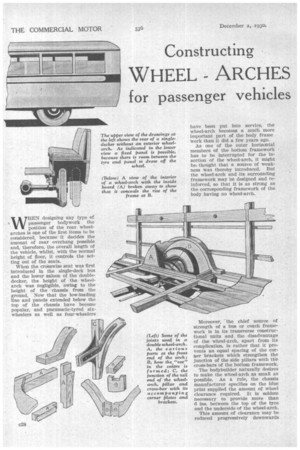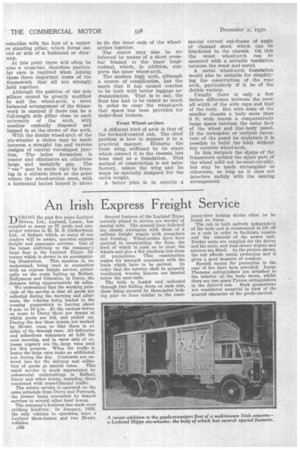Constructing
Page 50

Page 51

Page 52

If you've noticed an error in this article please click here to report it so we can fix it.
WHEEL ARCHES
for passenger vehicles
WHEN designing any type of passenger bodywork the position of the rear wheelarches is one of the first items to be considered, because it decides the amount of rear overhang possible and, therefore, the overall length of the vehicle, whilst, with the normal height of floor, it controls the setting out of the seats.
When the crosswise seat was first introduced in the single-deck bus and the lower saloon of the doubledecker, the height of the wheelarch was negligible, owing to the height of the chassis from the ground. Now that the low-loading line and panels extended below the top of the chassis have become popular, and pneumatic-tyred sixwheelers as well as four-wheelers have been put into service, the wheel-arch becomes a much more important part of the body frame work than it did a few years ago.
As one of the outer horizontal members of the bottom framework has to be interrupted for the insertion of the wheel-arch, it might be, thought that a source of weakness was thereby introduced. But the wheel-arch and its surrounding framework may be designed and reinforced, so that it is as strong as the corresponding framework of the body having no wheel-arch.
Moreover, the chief source of strength of a bus or coach framework is in its transverse constructional units and the disadvantage of the wheel-arch, apart from its complication, is rather that it prevents an equal spacing of the corner brackets which strengthen the junction of the side pillars with tile cross-bars of the bottom framework.
The bodybuilder naturally desires to make the wheel-arch as small as possible. As a rule, the chassis manufacturer specifies on the blue print supplied the amount of wheel clearance required. It is seldom necessary to provide more than 6 ins, between the top of the tyre and the underside of the wheel-arch.
This amount of clearance may be reduced progressively downwards towards the horizontal diameter of the arch, provided that there be not less than 31. ins, at this level. A side clearance of about 2 ins. is also necessary to allow for the roll of the chassis.
The size of the wheel-arch from front to back is considerable, because it has not only to cover one or a pair of tyres, but there is also the brake drum to clear, as well as the rise of the chassis over the back axle, which projects above the finer level and must be encased.
The wheel-arch consists, there
fore, of an inner curved member in addition to an outer one, between which a steel panel is fastened. As there is a good horizontal foundation for the inside arch it is often made up of strong boarding cut to shape, with a wood rail or steel plate fastened around its curved edge.
Opinions are about evenly divided as to whether the wheel-arch should be cut out of the plank in sections and spliced, or made of bent timber. The built-up method is preferred by many, because wheel-arch details differ so widely, owing to the varying disposition of the adjacent framework and depth of main panelling adopted. Moreover, it is not always possible to use a pair of standard wheel-arch bends if a sixwheeled-bus J5ody be under consideration. On the other hand, those who favour bent timber point out that the wheel-arch now often embraces half the circumference of the wheel, and if the arch is to be cut from timber straight grained, or almost so, the number of joints and extra pieces of timber required is greater than formerly.
The wheel-arch timber should he cut out so that a strong lap may be made at its junction with the bottom framework. In many instances the back end of the arch coincides with the foot of a corner or standing pillar, which forms one end or side of a bulkhead or doorway.
At this point there will often be also a cross-bar, therefore particular care is required when joining these three important items of the framework that all are strongly ,held together.
Although the position of the side pillars cannot be greatly modified to suit the wheel-arch, a more balanced arrangement of the framework is ensured if there can be a full-length side pillar close to each extremity of the arch, with another centrally disposed and lapped in at the crown of the arch.
With the double wheel-arch of the six-wheeler a choice may be made between a straight top and various designs of central vee-shaped junction. The latter formation is neater and eliminates an otherwise large and unsightly gap. The " vee " may be made rigid by framing in a suitable block at the point where the wheel-arches meet, with a horizontal batten lapped in above to tie the Inner ends of the wheelarches together.
The centre may also be reinforced by means of a short crossbar framed to the inner longitudinal, which, in addition, supports the inner wheel-arch.
The modern high arch, although a source of complication, has the merit that it has caused coaches to be built with better luggage accommodation. That is to say, the floor has had to be raised so much In order to clear the wheel-arch that space has been provided for under-floor lockers.
Front Wheel-arches.
A different kind of arch is that of the forward-control cab. The chief problem is how to support it in a practical manner. Hitherto the front wing, stiffened by its stays which connect it to the chassis, has been used as a foundation, This method of construction is not satisfactory, unless the wing and its stays be specially designed for the extra weight.
A better plan is to provide a special curved sub-frame of angle or channel steel, Which can be bracketed to the chassis. On this the wood wheel-arch can be mounted with a suitable insulation between the wood and metal.
A metal wheel-arch foundation would also be suitable for simplifying the construction of the rear arch, particularly if it be of the double variety.
Usually there is only a few inches difference between the overall width of the axle caps and that of the body. But with some of the smaller chassis a body more than 6 ft. wide leaves a comparatively large space between the outer face of the wheel and the body panel. If the turnunder, or vertical curvature of the panel be moderate it is possible to build the biidy Without any exterior wheel-arch.
In this instance the shape of the framework around the upper -part of the wheel ne-ed not be semi-circuliir, but may be made rectangular or otherwise, so long as it does not interfere unduly with the seating arrangement.












































































































